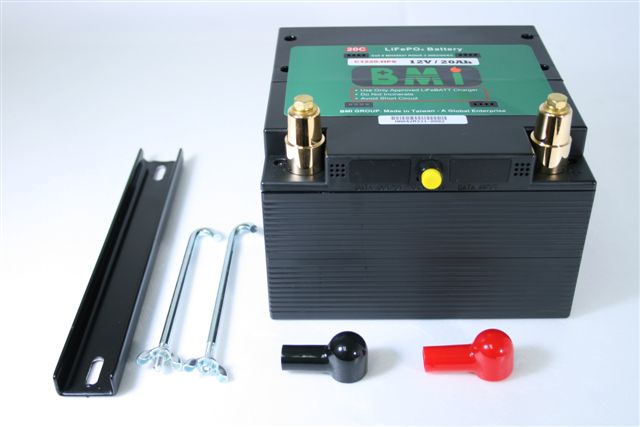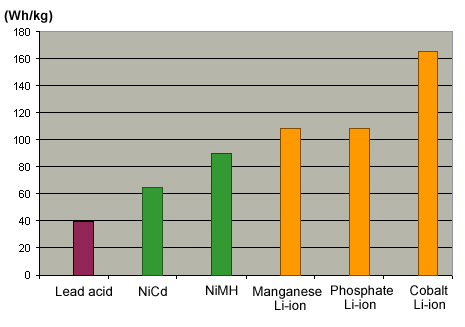Lithium Iron Phosphate (LiFePO4) Batteries
for recreational users including camper trailers, boating and
4WD applications

This
article explains the basic features regarding the latest
developments in lithium ion battery technology which have
recently become available to Australian recreational users.
Up to
the present time the camper trailer owner has only had available
one main type of battery to serve a multitude of remote
power applications. This of course is the lead acid battery.
There are two main variations to the lead acid battery depending
upon its specific application. This is the engine start (or
“cranking”) battery and the deep cycle variety with main types
in that family being the gel and AGM sealed lead acid types.
Broadly speaking the lead acid engine start battery is designed
to provide a short, high power burst of electrical current to
crank over a gasoline engine while starting.
The
other main type of lead acid battery is the deep cycle type
which is used to provide sustained power for electrical devices
and equipment over a long period. This is the type of battery
which is the best choice to power most common electrical
appliances used by camper trailer owners- either directly 12
volts from the battery itself or 240 volts from an inverter
connected to the battery.
Both
types of lead acid batteries however have severe limitations.
Lead
acid batteries are extremely heavy and while weight may not be
an important factor for batteries in a stationary environment
such as a fixed solar power installation, for use in a motive
application such as in a camper trailer, having to “carry” such
a heavy dead weight does not make much common sense. In addition
lead acid batteries contain many nasty chemicals such as
sulphuric acid and toxic heavy metals like lead which are
potentially hazardous for the environment.
Lead
is a very heavy metal and for many years the search has been on
to make a better battery that is also lighter in weight.
Lithium is the logical
choice since it is the lightest metal known to man. However in
addition to being extremely light in weight, lithium is also
extremely reactive and for this reason lithium metal is never
found in its pure metallic form in nature.
Lithium metal is manufactured from lithium salts which are
extracted through mining activities.
Lithium ion batteries
have been available for several years now and are in use in many
consumer applications.
As
with lead acid batteries, lithium batteries also are available
in several chemistries, each having their particular good and
bad points. The earliest lithium battery chemistries which
became a commercial reality and which are still in use today for
consumer items like mobile phones, notebook computers and
camcorders etc. are cobalt oxide lithium ion and manganese
lithium ion batteries. These batteries both have high energy
densities but have the disadvantage that in large format
applications and in cases where many separate cells are used
which can become unbalanced during several charge cycles, there
is the risk they can potentially become dangerous with a
possibility of fire or explosion occurring under certain
circumstances..
While
these batteries are generally considered quite safe in small
format applications, such as for mobile phones and the like
(generally one cell only is used therefore this is why the
battery voltage of a typical mobile phone battery is 3.6 -3.7
volts) there could be disastrous consequences should a large
lithium battery of this chemistry fitted in a camper
trailer catch fire.
There
are several documented examples where the more hazardous
chemistry of lithium ion batteries (lithium cobalt oxide) has
caught on fire and an example of this in recent years which many
people may be aware of is several instances where laptop
computer batteries caught on fire. This resulted in a
manufacturer recall of millions of batteries used in these
laptop computers.
In
the mid 1990’s Dr John B Goodenough and his research team from
the University of Texas developed material used to make the
Lithium Iron Phosphate battery (LiFePO4 for short).
Dr
Goodenough patented his invention and gave permission to
Phostech Lithium/Hydro Quebec Canada to manufacture this
material in commercial quantities for the production of LiFePO4
batteries which would be a superior replacement for lead acid
batteries.
More
information about Phostech Lithium can be obtained by going to
http://www.lifebatt.com/phosteclithium.pdf
Unlike the hazardous nature of the earlier chemistry lithium
battery types, lithium iron phosphate batteries are extremely
stable and safe to use. This safety combined with their light
weight has found wide use for these batteries for military
applications and now for commercial applications such as in
the recreational user market. These batteries are in fact even
safer than lead acid batteries and do not suffer from some of
the problems which are inherent to lead acid batteries such as,
thermal runaway, sulphation when left in a discharged condition
and high rates of self discharge if not used.
A
great advantage of LiFePO4 batteries is their extremely long
life. For a standby power application such as battery could be
expected to have a life of up to 20 years.
Lead
acid batteries generally have a life of only a few hundred deep
charge cycles while a quality LiFePO4 battery can typically be
charged in excess of 2000 times and there are LiFePO4 cells
which are currently under test at the US Department of Energy
Laboratories in New Mexico which have recently passed 7000
cycles and are still working.
Though not quite as high in energy density as the earlier
lithium battery types, the lithium iron phosphate battery still
has a far higher energy density compared to the lead acid
battery as can be seen from the graph below.

The
benefits to the camper trailer owner of a quality LiFePO4
battery are many.
Lithium iron phosphate is a truly multi-application battery so
the same battery can be used for both high power applications
such as engine cranking of the main campervan towing vehicle as
well as for power at the campsite in the place of a deep
cycle/AGM lead acid battery.
Another major factor which should be taken into consideration
when replacing a lead acid battery with a LiFePO4 battery is
that due to the higher energy density and greater performance of
the lithium battery, often a smaller battery can be used which
will provide equivalent performance to the original lead
battery. For many applications a 60Ah lithium iron phosphate
battery will provide equivalent performance to a 100Ah lead acid
battery. A 12V 20Ah LiFePO4 battery is all that is required for
a starting battery up to an engine size of 3000cc. This battery
weighs just over 4kg.
What
many battery owners and users fail to realise about the lead
acid battery is that its capacity (Ah) rating is usually
specified at the 20 hour discharge rate. At high rates of
discharge the useable capacity is reduced due to “Peukert’s
Effect”. A typical 100Ah lead acid battery when discharged in an
hour or two may have an actual measured capacity of as little as
60-70Ah.
As
soon as a load is placed on a lead acid battery there is a
sudden drop or “sag” in voltage. The voltage continues to
decrease until the battery is completely discharged. By contrast
the discharge characteristic of a LiFePO4 battery is very
different. The discharge curve is close to being linear. Even
under very heavy electrical loads a LiFePO4 battery will
maintain almost full power with very little reduction in nominal
voltage throughout its discharge cycle until the battery becomes
almost exhausted and in need of recharging.
Another great benefit of
these batteries for campervan owners is their inherent safety
features. Since they do not produce flammable hydrogen under any
circumstances (even if overcharged) a LiFePO4 battery can be
safely installed in a confined area in a caravan or campervan
without fear of a fire or explosion. Also due to the slim
cylindrical nature of LiFePO4 cells a custom battery of
virtually any shape or size can be custom manufactured which
will fit into any tight space even if the space is of an unusual
shape.
To sum up, an
overview of the benefits of Lithium Iron Phosphate batteries is
as follows-
·
Safe technology,
will not catch fire or explode with overcharge
·
Half the weight
of an equivalent capacity lead acid battery
·
Over 2000 deep
discharge cycles life compared to typically around 300 for lead
acid
·
Double the usable
capacity of similar amp hour lead acid batteries
·
Virtually flat
discharge curve means maximum power available until fully
discharged (no "voltage sag" as with lead acid batteries).
·
High discharge
rate capability, 10C continuous, 20C pulse discharge.
·
Unlike lead acid
batteries, can be left in a partially discharged state for
extended periods without causing permanent damage
·
Extremely low
self discharge rate (unlike lead acid which will go flat quite
quickly if left sitting for long periods)
·
Does not suffer
from "thermal runaway"
·
Can be used
safely in high ambient temperatures of up to 60 deg.C without
any degradation in performance
·
12.8V nominal, 8V
maximum discharge, 14.6V maximum charge voltage
·
Can be connected
in series for higher voltages or parallel for higher capacity.
·
Absolutely
maintenance free for the life of the battery
·
Can be operated
in any orientation including inverted
·
Does not contain
any toxic heavy metals such as lead, cadmium, nor any corrosive
acids or alkalis thus making LiFePO4 batteries the most
environmentally friendly battery chemistry available
It
will not be long before several brands of LiFePO4 batteries will
be available to campervan owners. When selecting a particular
brand the battery purchaser should consider a brand which uses
cathode material manufactured by the inventor and patent holder
of this technology (Phostech Lithium Canada). Such a battery
should come with a warranty of at least 3 years and more than
1000 charge cycles.
Due
to the much higher initial cost of a LiFePO4 battery, several
cheap Chinese pirated copies have now entered the market. The
prospective battery purchaser should be very wary when
considering purchasing one of these batteries since one reason
for their lower price is that the Chinese manufacturers do not
pay royalties to the patent holder and as such the cathode
powder used in their manufacture is of a much lower quality and
the battery can be expected to have a much shorter lifespan
combined with overall poorer performance. There are a handful of
manufacturers of first grade quality Lithium Iron Phosphate
batteries which will outlast several lead acid batteries and
provide vastly superior performance to the lead based battery.
Lithium Iron Phosphate
batteries are sure to revolutionise
remote power requirements for camper trailer owners in coming
years by enhancing the amount of power which can be stored in a
given size battery thus allowing camper trailer owners access to
a source of longer sustained electrical current to power
electrical equipment for longer while exploring the great
outdoors.
Information provided by
Armin Pauza
General Manager & Principal Electrical
Engineer
Lithium Batteries Australia
ph. 0420 948 757
info@lifebatt.com.au